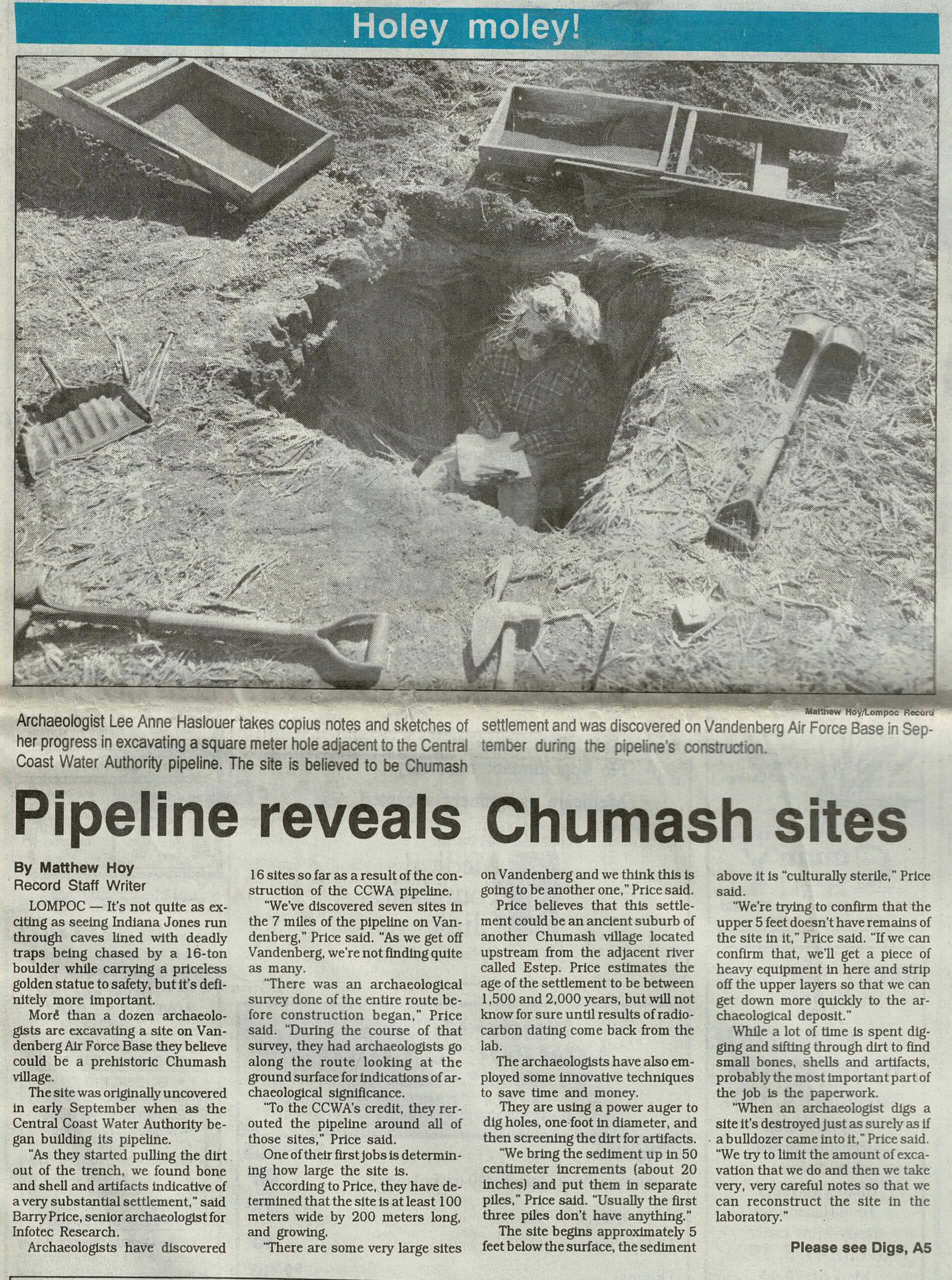By Matthew Hoy
Record Staff Writer
LOMPOC—It's not quite as exciting as seeing Indiana Jones run through caves lined with deadly traps being chased by a 16-ton boulder while carrying a priceless golden statue to safety, but it's definitely more important.
More than a dozen archaeologists are excavating a site on Vandenberg Air Force Base they believe could be a prehistoric Chumash village.
The site was originally uncovered in early September as the Central Coast Water Authority began building its pipeline.
"As they started pulling the dirt, out of the trench, we found bone and shell and artifacts indicative of a very substantial settlement," said Barry Price, senior archaeologist for Infotec Research.
Archaeologists have discovered 16 sites so far as a result of the construction of the CCWA pipeline.
"We've discovered seven sites in the 7 miles of the pipeline on Vandenberg," Price said. "As we get off Vandenberg, we're not finding quite as many.
"There was an archaeological survey done of the entire route before construction began," Price said. "During the course of that survey, they had archaeologists go along the route looking at the ground surface for indications of archaeological significance.
"To the CCWA's credit, they re-routed the pipeline around all of those sites," Price said.
One of their first jobs is determining how large the site is.
According to Price, they have determined that the site is at least 100 meters wide by 200 meters long, and growing.
"There are some very large sites on Vandenberg and we think this is going to be another one," Price said.
Price believes that this settlement could be an ancient suburb of another Chumash village located upstream from the adjacent river called Estep. Price estimates the age of the settlement to be between 1,500 and 2,000 years, but will not know for sure until results of radiocarbon dating come back from the lab.
The archaeologists have also employed some innovative techniques to save time and money.
They are using a power auger to dig holes, one foot in diameter, and then screening the dirt for artifacts.
"We bring the sediment up in 50 centimeter increments (about 20 inches) and put them in separate piles," Price said. "Usually the first three piles don't have anything."
The site begins approximately 5 feet below the surface, the sediment above it is "culturally sterile," Price said.
"We're trying to confirm that the upper 5 feet doesn't have remains of the site in it," Price said. "If we can confirm that, we'll get a piece of heavy equipment in here and strip off the upper layers so that we can get down more quickly to the archaeological deposit."
While a lot of time is spent digging and sifting through dirt to find small bones, shells and artifacts, probably the most important part of the job is the paperwork.
"When an archaeologist digs a site it's destroyed just as surely as if a bulldozer came into it," Price said. "We try to limit the amount of excavation that we do and then we take very, very careful notes so that we can reconstruct the site in the laboratory."
By studying this settlement they hope to learn how earlier civilizations coped with issues like drought.
"We hope to learn how people survived, how people adapted to, cycles of drought," Price said. "What works and what doesn't work to survive long-term droughts and I think that's something that is directly relevant to modern society."
While the settlement is ancient history to most of today's residents of the Lompoc Valley, it's heritage to descendants of the Chumash.
Elise Tripp, a direct descendant of the original Chumash inhabitants, is monitoring the dig for the local Chumash community.
"Right now I hope to find the boundaries of the village," Tripp said. "My ancestors didn't have boundaries.
"This has always been my favorite activity," Tripp said, who often works at the Santa Barbara Museum of Natural History. "These are things that I can bring home to my children. They're more in tune to nature."
She was enthusiastic about the opportunity for learning that the village represents.
"Now it is acceptable to learn about Chumash culture," Tripp said. "There is a lot of t has not been documented. This will benefit the youth and put them at a higher level of knowledge."
Once the artifacts have been studied, they will be permanently housed at UC Santa Barbara, Price said.
Published Friday, November 4, 1994, The Lompoc Record.
